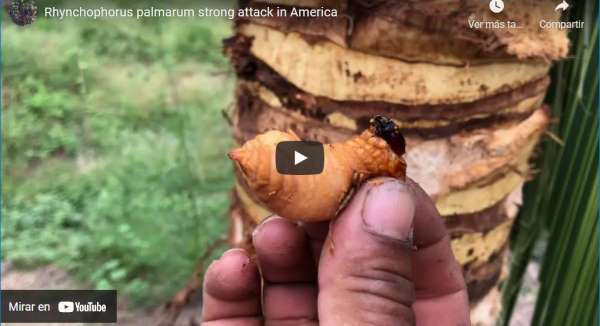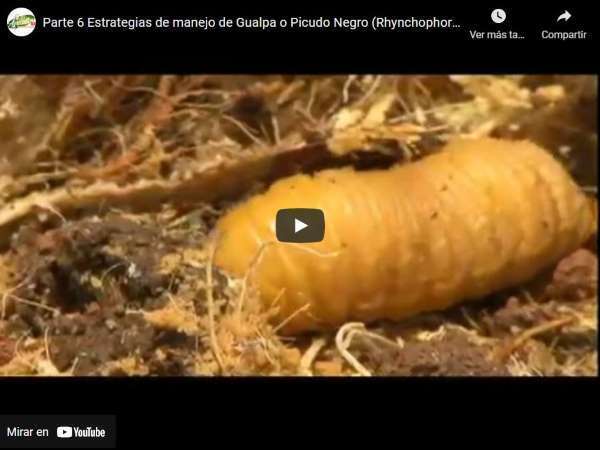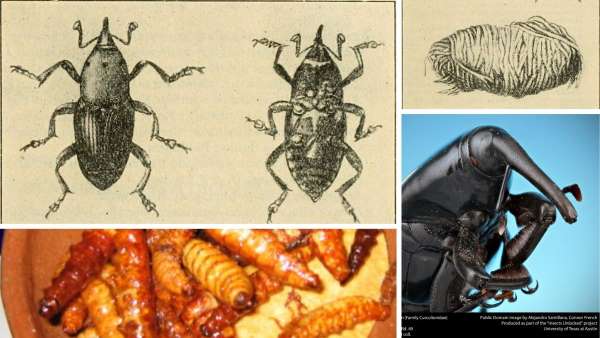
An insect that’s bad for agriculture but good for human consumption
The suri, chontacuro, or larva of the Rhynchophorus palmarum beetle, is at the same time a plague, a super-food, and even a medicine.
It is a pest because it destroys commercial crops, causing significant economic losses.
It is a super-food due to its high nutritional value, used by many indigenous Amazonian communities to complement their diet, especially during times when hunting and fishing products are scarce.
And it is also used as a medicine, for purposes that will be shown below …
▷ Taxonomy
The beetle Rhynchophorus palmarum belongs to the order Coleoptera, family Curculionidae, tribe Rhynchophorini. The genus Rhynchophorus consists of ten species. Of these, three are present in the neotropics: R. cruentatus, R. richeri and R. palmarum.

Source: USA, TX, Bastrop Co. Little Sandy Creek at Co. Rd. 49
29.iv.1995 R. Stanford coll. (Public domain)
▷ Habitat
Rhynchophorus palmarum is a widely distributed species in the neotropics, from southeastern California and Texas to Bolivia, Peru, Paraguay, Uruguay, and Argentina, at an altitude that ranges from 0 to 1,200 meters above sea level (Watanapongsiri, 1966; Jaffé and Sánchez, 1992; Sanchez and Cerda, 1993).
Common names
This interesting insect is known by many common names: cucarrón, cigarrón, weevil, palm weevil, casanga, black weevil, and coconut palm weevil .
Its larva is called in the Amazonian regions suri (Peru), chontacuro, mukint, mukindi (Ecuador), gualpa (Colombia), palm worm (Venezuela), apart from the many other names that are given in the different parts of the Amazon basin: mojojoi, mojomoi, mojotoi, casanga, mujín, budworm, ou, yoi-teguei, etc.
✅ Description of Rhynchophorus palmarum and its larva stages
It is a matte black beetle, with a size that varies between 2 and 5 cm.
In the adult state, this beetle presents sexual dimorphism, that is, the male differs from the female.
The female has a curved and smooth beak, longer than that of the male.
The male is easily recognized because, in addition, it has a plume of setae on the dorsal part of its beak.
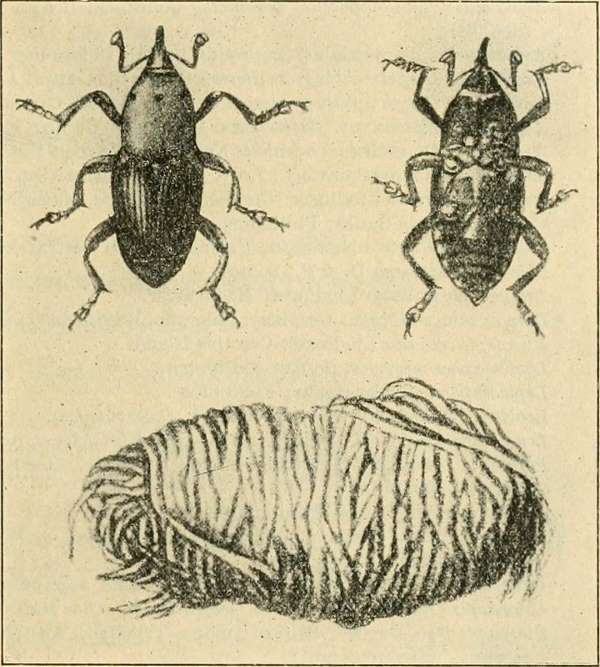
Authors : Societe nationale d’acclimatation de France
Subjects : Zoology
Publisher : Paris : Au Siège de la Societe
Contributing Library : Smithsonian Libraries
Digitizing Sponsor : Smithsonian Libraries / No Known Copyright Restrictions
Behavior
Both male and female are active both during the day and at night. They are seen on fallen palm trunks during the early morning or late afternoon. Although they are most active around 11 p.m. (Aldana de la Torre et al , 2015: 11-13, Mexzón, Chinchilla, Salamanca, 1994; Griffith, 1987).
Reproduction
The female lays creamy white eggs, with a size that fluctuates between 2.5 and 1.0 mm.
She deposits them, on average 900 units, in a vertical position on the soft tissue of the open trunk of the palm, protecting it with a brown waxy substance.
After two to four days, the larvae emerge, without legs. At this stage, its body is a little over 3mm long, slightly curved at the belly.
From there, its development begins in nine stages, which last between 42 and 62 days. When it reaches stage IX, it becomes a pupa.
Then, it takes 30 to 45 days for the adult to emerge, and 7 to 11 days more to leave the cocoon (Aldana de la Torre at al , 2015; Aldana de la Torre et al , 2011)
The females oviposit in the cuts of the petiolar bases of palms with wounds or decay.
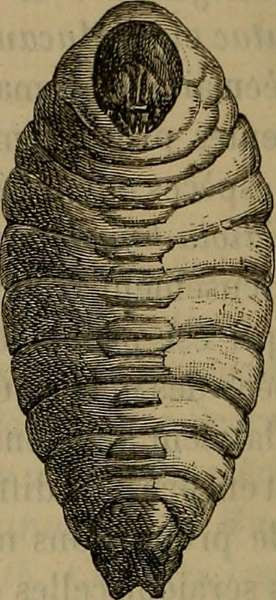
Title : Bulletin of the Société nationale d’acclimatation de France
Identifier : bulletindelasoci42188532soci
Year : 1882 ( 1880s )
Authors : Societe nationale d’acclimatation de France
Subjects : Zoology
Publisher : Paris : Au Siège de la Societe
Contributing Library : Smithsonian Libraries
Digitizing Sponsor : Smithsonian Libraries / No Known Copyright Restrictions
Life cycle of the suri or chontacuro
There, inside the infected palm (generally due to bud rot), the insect develops, completing its entire life cycle (Aldana de la Torre et al , 2011: 21), depending on the material or substrate on which it feeds (colonized substrate).
The life cycle ranges from 119 to 231 days. When reared in the laboratory (Genty et al , 1978) under normal conditions, it takes a minimum of 122 days: 3.5 days as an egg, 60.5 days as a larva, 16 days as a nymph and 42 days as an adult (González and García, 1992; Pérez and Innacore, 2006; Ramos-Elourdoy and Viejo, 2007).
Females have an oviposition period of up to 43 days.
A female can lay up to 63 eggs in one day, and from 697 to 924 during her entire cycle (Aldana de la Torre et al, 2015 ; Sánchez et al , 1993; González Camino, 1974, Hagley, 1965). In the final stage, the larva has a length of 5 to 6 cm, and a weight of 12 to 30 g (Cerda, et al, 2001).
The females of the Rhynchophorus palmarum are attracted to the volatile compounds that emanate from the palms with wounds or rotting, seeking to feed on their soft tissues.
Host plants
Thirty-one species of host plants of the suri or chontacuro have been recorded, belonging to 12 families. Among them, the Palmaceae family predominates with 19 species, mainly Elaies guineensis and Cocos nucifera, all of great economic importance.
Of the 19, there are 11 species of Amazon palms that are hosts to Rhynchophorus palmarum. Among them, Mauritia flexuosa, Maximiliana regia, Bactris gasipaes, Oenocarpus bataua, Euterpe oleracea, and Astrocaryum huicungo are all of great importance for human consumption in the Amazon basin.
Of the 11, three species of palms are highly affected: buriti, aguaje, morete, muriti or moriche (Mauritia flexuosa), ungurahui, ungurahua or seje (Oenocarpus bataua) and cucurito (Maximilian regia) (Barragán and Carpio, 2008).
Rhynchophorus palmarum, a polyphagous insect, also causes damage to fruit trees such as papaya, mango, avocado, orange, and aguava by feeding on the ripe fruits, and in addition, on sugar cane, bananas, cocoa, and pineapple.
But there is a difference: on many of these plants, Rhynchophorus palmarum causes damage, but does not behave like a pest, which is limited to just palms and sugar cane (Aldana de la Torre et al , 2015; Sánchez and Cerda, 1993).
✅ Rhynchophorus palmarum as plague
Rhynchophorus palmarum is a devastating pest of some economically important palms located in commercial plantations, such as coconut and oil palm, as well as some Amazonian palms of great utilitarian interest for the native indigenous communities (Cartay, 2016: 151-156).

When Rhynchophorus palmarum is attracted to wounds and rots on the stems and buds of palms, it lays its eggs in the soft tissues, infecting the palm with the nematode Bursaphelenchus cocophilus (hereafter Bc), the main cause of the red ring syndrome or small leaf, which has devastated coconut and African palm plantations in Central and South America.
The Bc nematode is an obligate migratory endoparasite, which lives its entire life inside the palm, but without multiplying inside the disseminating insects (Aldana de la Torre et al , 2015).
The nematode is acquired by the larva of Rhynchophorus palmarum, which acts as its main vector, maintaining it through the molts until it reaches the adult stage.
When leaving the diseased palm, it can infect three or four neighboring healthy palms, causing serious damage (Mosquera-Blandín; Viáfara, 2008).
Control methods for this pest
The combat and control campaign is carried out using traps or plastic containers (olfactory capture traps), placing synthetic or natural aggregation pheromones to attract insects.
Traps are placed in the field at a distance of one to two hectares in the most infected areas (Chinchilla and Escobar, 2007; Couturier et al, 1996; Chinchilla, Menjivar and Arias, 1991).
✅ Rhynchophorus palmarum as food
In the case of the Amazon basin, the larvae of the beetles Rhynchophorus palmarum and Rhinostomus barbirothis are the most consumed (Araujo et al , 2007; Dufour, 1987), although the great majority are Rhynchophorus palmarum (Paoletti et al , 2001).
It should be noted, however, that this statement cannot be generalized for all the countries of the basin. A very notable exception is Brazil, where the Amazon region mainly consumes hymenopteran insects (ants, termites, wasps and bees) (Costa-Neto and Ramos-Elourdoy, 2006: 423; Jara, 1996). The consumption of Rhynchophorus palmarum exists, although there were not many studies in this regard, at least until the late 1970s (Posey, 1978).
First scientific studies of Rhynchophorus palmarum
It is interesting to mention that one of the oldest references on the consumption of Rhynchophorus palmarum in the Brazilian Amazon dates back to 1844, made by Marte (Coimbra, 1983).
Research carried out by Coimbra (1983) among the Suruí indigenous people of Rondonio, Brazil, confirmed the consumption of Rhynchophorus palmarum and Rhia barbirostris larvae .
The members of this people call it kadeg and mjora interchangeably. But they give it other names, depending on the species of plant they are obtained from, in which case they use the suffix teguei. If they get them from Jaractia dodecaphylla (known as ihboga), the larvae are called ihboga-teguei, and if they get them from Jessenia bataua (yoi), they name them yoi-teguei.
Protein source
The larvae of Rhynchophorus palmarum are a source of protein and fat used in native Amazonian indigenous communities to supplement a diet normally based on hunting, fishing and farming.
This protein source could also be used as food by other populations, since the Rhynchophorus palmarum larva, as well as edible insects in general, constitutes a protein source of high biological value and low cost.
Where to buy?
It is interesting to note that in urban areas of many Amazonian regions, edible insects are freely sold.
In the markets of Iquitos, the larvae of Rhynchophorus palmarum are sold in different forms: live, cooked, and roasted. Vargas et al (2013: 65) pointed out that an average of 3,500 units are sold there per day, especially on weekends.

Use of edible insects in the Amazon
Although not openly discussed, the consumption of insects is common throughout the Amazon basin.
This is evident if one pays a visit to any indigenous community during the rainy season.
In some native communities of the Loreto region in the Peruvian Amazon, I directly recorded the consumption of nine species of insects belonging to various orders.
The most consumed was Rhynchophorus palmarum, in close association with the wide geographical distribution and the abundance of some host plants such as Mauritia flexuosa (aguaje). In the low jungle there are huge stands of this palm that are known as aguajales (Cartay, 2016:160).
Preparation modes
The indigenous people consume the larvae fresh, alive or dead, roasted, or fried.
In the urban areas of the Amazon, they are served fried in their own fat, or roasted over direct heat. This form of preparation and consumption constitutes an imitation of the indigenous way.
The most sophisticated urban chefs offer their product in a salad, or wrapped in the manner of a tequeño, or threading the larvae on a skewer as if it were a Turkish kebab.
This is what happens in the restaurants of Iquitos, Peru; Puyo, Ecuador; Leticia; Colombia; or Puerto Ayacucho, Venezuela.
Other cooks have incorporated the larva in some typical preparations of regional cuisine from the Peruvian Amazon. Thus, we have the juane de chonta (palmito), which mixes palmita, a tender edible inflorescence of some Amazonian palms, with suris or palm worms (Chirif, 2016).
Brewer-Carias (2013: 150) recommends cutting the end of the larva before consuming it raw, to reduce its pungent taste, which is probably caused by its digestive juices.
This is how it is consumed by the Yanomamo, from the border of the Amazon between Brazil and Venezuela. The members of these communities bite the larva behind the crooked head and remove the intestines and the head with their teeth (Chagnon, 1968).
Nutritional value
In the specific case of the Rhynchophorus palmarum larva, the protein content is 76%, clearly higher than that of beef, which is 50 to 57%.
Similarly, the fat content of the Rhynchophorus palmarum beetle larva is higher and presents a better composition, ranging between 21 and 54%, compared with a range of 17% in fish to 19% in beef.
The skin, in particular, is rich in oils. These are fatty oils of the unsaturated type: linoleic, linolenic and other polyunsaturated fats (Cerda et al , 1999; Cerda et al, 2001; Bukkens, 2005; Ramos-Elourdoy, 2005; Váldez and Untiveros, 2010; Sancho, 2012; Landívar- Valverde, 2012; Vargas et al , 2013; Sancho, Álvarez and Fernández, 2015).
Regarding the total caloric value, the beetle larvae have caloric values around 560 kcal/100 g, higher than the 430 kcal/100 g of beef (Costa-Neto and Ramos-Elourdoy, 2006). .
✅ Suri or chontacuro protoculture
The insect in the Amazon basin is the object of collection activity carried out by the indigenous Amazonian communities.
To that end, it is necessary to know the changes produced in the larva. The lapses of the instars, or stages, of Rhynchophorus palmarum are important to determine the collection period in the forest.
This is a knowledge that the indigenous handle perfectly and that they transmit from generation to generation, referred to as ethnoethology by Posey (1976).
Harvest times
To collect the insect, at least one week must have passed after its incubation period to guarantee that it is already a larva.
It must also have reached a weight close to 12 g, and be as fat as a finger.
Another characteristic that demonstrates its ideal stage of evolution for harvesting is its color — between cream and brown.
Guzmán-Mendoza (2011) points out that it is important to distinguish the larva phase to be considered as food.
Ideal conditions occur after about two months of life, once the infestation period has occurred, which does not happen immediately after felling the palm. Some periods are more favorable than others to infest felled logs.
Infestation or “seeding” times
Ramos-Elourdoy et al (2007) point out that the period of greatest infestation occurs in the Amazon between August and October, depending on the areas and the rainy season.
It is normally in those months when stem rotting accelerates, making the trunk softer and permitting perforation by the insect. This occurs naturally or is induced by man.
When human action intervenes, the collecting activity goes much further, becoming in practice a task of cultivation or proto-cultivation, as Ramos-Elourdoy and Viejo (2007) called it.
In this case, the indigenous people fell the palm, and make an incision of approximately 10 by 10 cm in the felled trunk, then leaving a mark to identify it.
Two months later they return to the site, knowing what to look for and where (Ortiz-Quijano, 1993).
The palm is felled in the forest at an age of 30 to 40 years, causing ecological damage. Although abundance of the palm species is recorded, damage can be avoided when the larva is reared in the laboratory.
Collection
After some time, 35 to 40 days, which the indigenous people know well, they return to the site, but this time carrying an ax and a container to collect the larvae.
They split open the bark of the trunk with the axe, and extract 30 to 40 larvae each time, or a day’s harvest.
A whole palm tree can produce a total of 500 larvae. Then, the collector takes the larvae home to eat with his family.
The date of greatest collection in the Peruvian Amazon is from July to October, both in the low and high jungles.
Depending on the season, the collectors change. During the hunting or fishing season, when the men are absent from the community, the collection is undertaken by the women and children.
The Suruí from Brazil hear “the larvae speak,” crouching down and pressing their ears to the infested trunk. Then it is time to collect them (Coimbra, 1983).
The “culture” or “protoculture” of Rhynchophorus palmarum is not a simple task.
Induced infestation
Araujo and Becerra (2007) and Arango-Gutiérrez (2012) point out that the Yekuana and Piaroa ethnic groups of the Venezuelan Amazon induce the breeding of Rhynchophorus palmarum, a practice they recognize as a great culinary virtue.
They collect the larvae from the fallen palm trunks and move them to their homes, where they feed and breed them (in this process a high level of cannibalism is recorded among the larvae if they are not separated into individual cells).
As food for the larvae, pieces of soft vegetable tissues from trunks of selected palms are used.
In some cases, such as in the Ecuadorian Amazon among the Shuar, pieces of papaya and sugar cane are used (Moquecho-Saltos; Quezada-Quezada, 2017).
Some prefer to use tissues from the seje palm (Jessenia bataua), arguing that by consuming them, the larvae acquire a better flavor.
For their “cultivation” they intentionally cut down healthy palms, sectioning their trunks longitudinally to attract and concentrate a greater number of infesting individuals in the food source, favoring copulation and oviposition. After a period of 35 to 45 days, they harvest the larvae and consume them, cooking them over low heat until they are crispy.
Bukkens (2005) points out that harvesting is planned and highly predictable when inducing infestation of the felled trunk.
✅ The Rhynchophorus palmarum as medicine and symbol
It is well known that, when consuming food, symbols, meanings, and signifiers are consumed at the same time. In this way, the consumption of insects goes beyond simply obtaining nutrients in times of scarcity or to offset protein and fat deficiencies. Every food substance must be seen from a three-dimensional perspective, since it provides, at the same time, nutrients, medicines and symbols.
The consumption of insects in the different regions of the Amazon basin is part of a culture reflecting this triple condition, whose members use symbols to think about themselves as individuals and as a social entity, and to express themselves and think about their culture.
In the Shuar ethnic group from the Morona Santiago province in the Ecuadorian Amazon, topical creams are made from the larvae to relieve arthritic and rheumatic pain, and live larvae are given to children suffering from anemia to cure them (Marquecho-Saltos; Quezada- Quezada, 2017).
Food contains messages or stories that serve, along with other cultural elements, to insert themselves into the world or imagination of a culture. These messages are transmitted inter-generationally and incorporated, with adjustments, in the eating patterns of a social group (Washlqvist and Lee, 2007).
✅ Myths, legends and customs around this beetle
Macera and Casanto (2011:242) mention that for the members of the Ashaninka indigenous Amazonian ethnic group, the suri larva (imooqui) has an owner or tutelary god, the imoobo, from whom permission must be sought to consume the insect.
In Asháninka legend, the imoobo is an old lady who ended up getting addicted to eating so much suri.
Jara (1996: 226), for his part, reported that the Andoque and Desana, indigenous peoples of the Colombian Amazon and great consumers of Rhynchophorus palmarum, see in the metamorphosis of the insect the expression of a transforming magical power.
The beetle, considered to be the father of the larva, is attributed a masculine generative power, which penetrates with its beak, the penis, the perforated trunk of the palm, which corresponds to the vagina. The larva is, for them, a hybrid animal/vegetable product that is produced within a shamanistic transformation process.
The Yucuna, from the Colombian Amazon, distinguish between three types of Rhynchophorus palmarum beetle larvae, which they call mojojoi: the mumuna (small), the huachurú (medium), and ñamaja (big).
The larvae are collected by women and children and bartered or donated. Giving them away is a demonstration of affection, wrapping them in pieces of palm leaves and tying them with rattan fibers (Ortiz-Quijano, 1993: 8-9).
The consumption of insects in cities
The symbolism of insect consumption is different when it occurs among non-Amazonian urban consumers.
In the consumer’s imagination, the edible insect leaves everyday life to become an exotic material that, in some cases, is full of amazement and can become an object of consumption and gastronomic tourism.
But in most cases it creates rejection, because the insect is considered a dirty element with an unpleasant appearance, arousing feelings of apprehension and disgust and causing phobia and nausea.

Dr. Rafael Cartay is a Venezuelan economist, historian, and writer best known for his extensive work in gastronomy, and has received the National Nutrition Award, Gourmand World Cookbook Award, Best Kitchen Dictionary, and The Great Gold Fork. He began his research on the Amazon in 2014 and lived in Iquitos during 2015, where he wrote The Peruvian Amazon Table (2016), the Dictionary of Food and Cuisine of the Amazon Basin (2020), and the online portal delAmazonas.com, of which he is co-founder and main writer. Books by Rafael Cartay can be found on Amazon.com
This post is also available in:
![]() Español (Spanish)
Español (Spanish)

